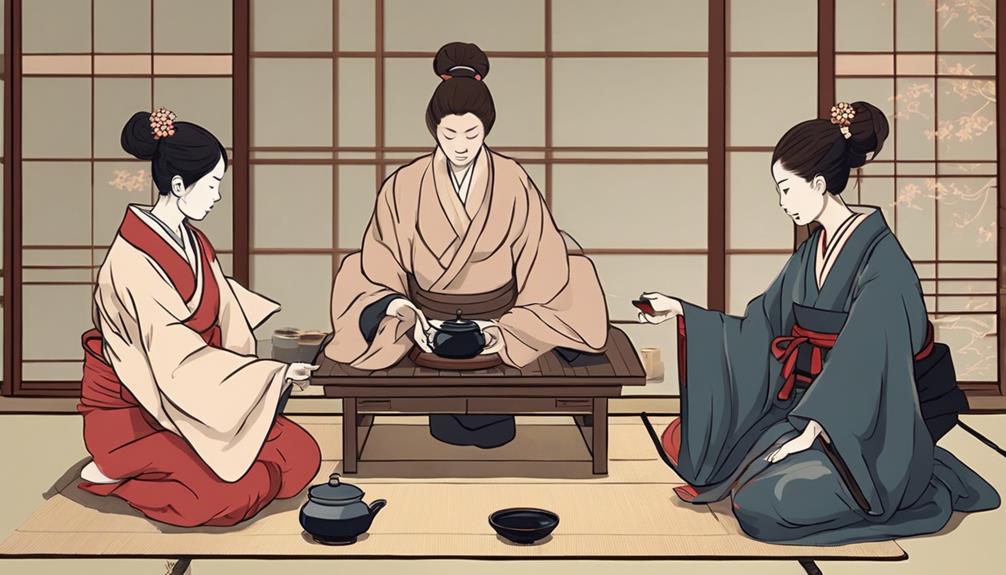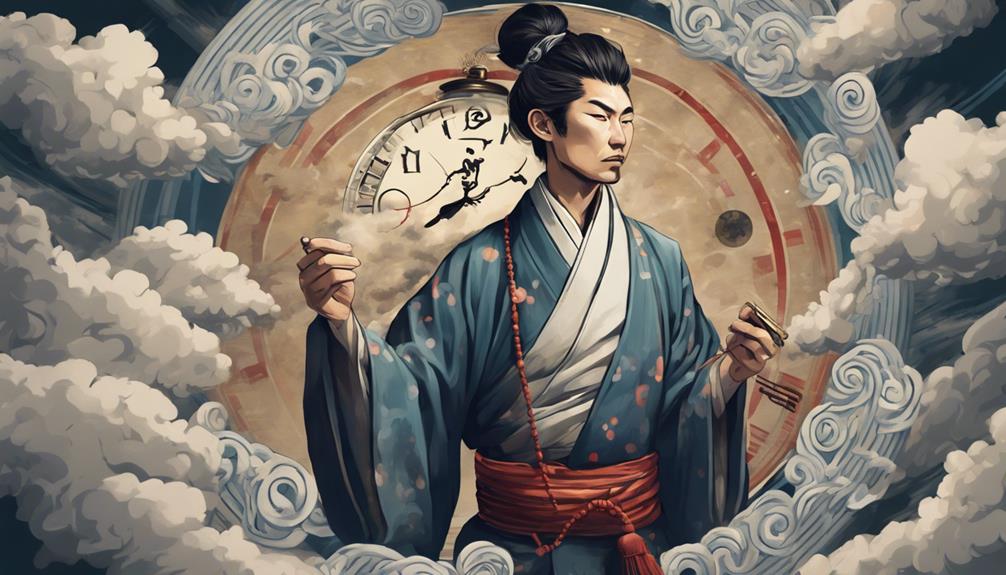Japanese hypnosis, emerging in the early 20th century, blends Western therapeutic methods with Eastern philosophies for a holistic approach to health. Techniques like guided imagery, suggestion therapy, and mindfulness are commonly used. This practice integrates Eastern philosophies stressing harmony and balance, emphasizing the mind-body connection through visualization and energy work. Unlike Western hypnosis focusing on direct suggestions, Japanese hypnosis nurtures rapport and connection with subtle, indirect approaches. Employed in modern settings, it aids in stress relief, addiction treatment, and personal development. Discover more about its key techniques, cultural influences, and benefits for personal growth and health.
Origins of Japanese Hypnosis

The origins of Japanese hypnosis can be traced back to the early 20th century when it began to gain recognition as a therapeutic technique influenced by Western practices. Historical roots reveal that Japanese physicians and psychologists were intrigued by the potential of hypnosis in treating various psychological and physical ailments, leading to the integration of hypnotherapy into mainstream medical practices.
Over time, Japanese hypnosis evolved to encompass a blend of traditional Eastern philosophies and modern Western therapeutic approaches.
In contemporary times, Japanese hypnosis continues to be utilized in a variety of settings, including clinical therapy, self-improvement programs, and entertainment. The modern practices of Japanese hypnosis often incorporate techniques such as guided imagery, suggestion therapy, and mindfulness to induce a state of focused attention and heightened suggestibility in individuals.
This fusion of historical knowledge with innovative methods has enabled Japanese hypnosis to remain a relevant and effective tool for addressing a wide range of issues in today's society.
Key Techniques and Practices
Commonly employed in Japanese hypnosis are a variety of techniques and practices aimed at inducing a deep state of relaxation and heightened suggestibility in individuals. Hypnotic induction methods, such as progressive relaxation, visualization, and focused attention, are frequently utilized to guide individuals into a trance state.
Once in this initial trance state, deepening techniques like counting down, rhythmic breathing, or guided imagery are employed to deepen the level of hypnosis.
Suggestibility testing plays a pivotal role in Japanese hypnosis, allowing the practitioner to assess the individual's responsiveness to hypnotic suggestions. These tests can include simple suggestions like arm levitation or eye catalepsy to gauge the depth of trance and suggestibility levels.
Cultural Influences and Traditions

Influenced by centuries-old traditions and deeply ingrained cultural beliefs, Japanese hypnosis incorporates unique elements that shape its practice and effectiveness. Historical significance plays a pivotal role in Japanese hypnosis, with the practice dating back to ancient times when it was used in spiritual rituals and traditional healing methods.
Cultural rituals, such as tea ceremonies and meditation practices, have also influenced the development of hypnosis techniques in Japan, emphasizing the importance of harmony, respect, and mindfulness in the process. Traditional methods of Japanese hypnosis often involve a more indirect and subtle approach compared to Western practices, focusing on building rapport and establishing a deep connection with the individual.
However, contemporary influences have started to blend with these traditional methods, incorporating modern psychological theories and techniques to enhance the effectiveness of Japanese hypnosis. This combination of historical significance, cultural rituals, traditional methods, and contemporary influences creates a unique and multifaceted approach to hypnosis in Japan that continues to evolve and adapt to the changing times.
Contrasts With Western Hypnosis
Uniquely diverging from Western practices, Japanese hypnosis showcases distinctive methodologies rooted in centuries-old traditions and cultural influences. One of the key differences lies in the incorporation of Eastern philosophy into Japanese hypnosis techniques. Eastern philosophy emphasizes harmony, balance, and interconnectedness, which are integrated into the hypnotic process. This contrasts with Western hypnosis, which tends to focus more on direct suggestions and behavioral changes.
Moreover, Japanese hypnosis places a strong emphasis on the mind-body connection. This concept stems from the belief that the mind and body are deeply interconnected, and any imbalance in one affects the other. Practitioners of Japanese hypnosis often work to align the mind and body through techniques such as visualization, breathing exercises, and energy work. In contrast, Western hypnosis typically approaches the mind and body as separate entities, with less emphasis on their interrelation.
Applications in Modern Society

The application of Japanese hypnosis in modern society demonstrates its potential to address various psychological and physical health concerns through holistic and culturally-rooted approaches. In the context of workplace stress and performance enhancement, Japanese hypnosis techniques can help individuals manage stress levels, improve focus, and enhance overall performance in professional settings. By incorporating traditional Japanese relaxation techniques and mindfulness practices, hypnosis can provide employees with valuable tools to cope with the demands of the modern workplace.
Moreover, Japanese hypnosis has shown promise in addiction treatment by addressing underlying psychological factors contributing to addictive behaviors. Through tailored hypnotherapy sessions, individuals struggling with addiction can work towards breaking destructive patterns and achieving long-term recovery.
Additionally, Japanese hypnosis is effective in providing relief from phobias by helping individuals explore the root causes of their fears and gradually desensitize themselves to triggering stimuli. By combining cultural elements with evidence-based therapeutic approaches, Japanese hypnosis offers a unique and effective way to address a variety of psychological and physical health issues in modern society.
Benefits for Personal Development
Empirical studies have demonstrated the potential benefits of Japanese hypnosis for personal development, showcasing its effectiveness in enhancing self-awareness and fostering positive behavioral changes. In the domain of self-improvement and mental wellness, Japanese hypnosis techniques offer individuals a unique avenue to explore their inner selves, confront limiting beliefs, and cultivate a more positive mindset. By delving into the subconscious mind during hypnosis sessions, individuals can address deep-seated issues, anxieties, and traumas that may be hindering their personal growth.
Furthermore, Japanese hypnosis has been found to bolster confidence levels and motivation in individuals seeking to break free from negative thought patterns. Through targeted suggestions and visualization techniques, hypnosis can empower individuals to build self-confidence, set and achieve personal goals, and maintain a resilient mindset in the face of challenges. This enhanced self-belief and motivation can lead to greater overall well-being and a more fulfilling life experience for those who engage with Japanese hypnosis for personal development.
Conclusion
To sum up, Japanese hypnosis offers a unique approach to personal development rooted in cultural traditions and key techniques. Its contrasts with Western hypnosis highlight the diversity of hypnotic practices worldwide.
The applications of Japanese hypnosis in modern society demonstrate its potential benefits for individuals seeking personal growth. Overall, Japanese hypnosis presents a fascinating and effective method for achieving self-improvement through the utilization of culturally influenced techniques.
Dr. John Renoldson is a distinguished professor of Clinical Research Hypnotherapy He holds a PhD in Clinical Psychology and specializes in hypnotherapy and scientific research to enhance therapeutic outcomes. Dr. Renoldson has authored numerous peer-reviewed articles on the efficacy of hypnosis in treating conditions.




